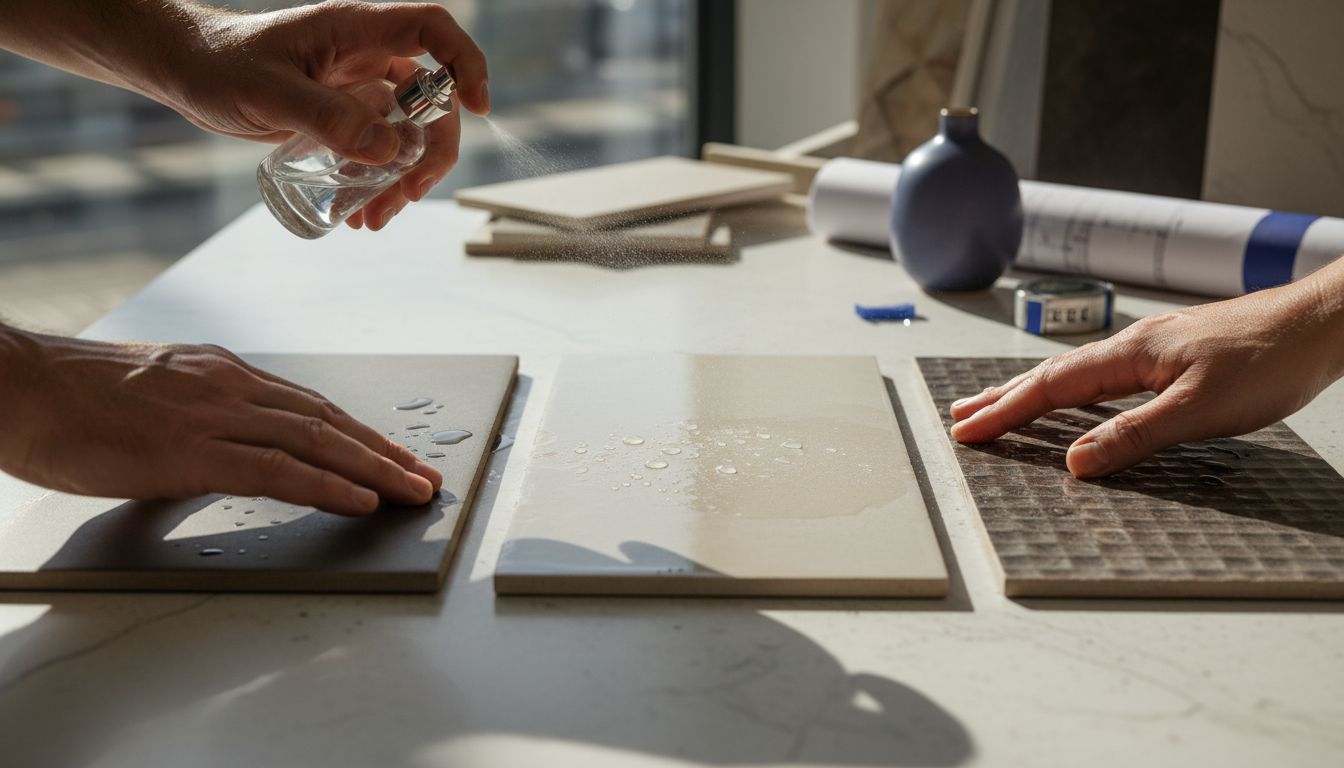
How to Choose Slip-Resistant Tiles for Safe Surfaces
Share
Every year, falls at home send over 235,000 people in the UK to the hospital with many accidents caused by slippery floors. Simple choices like the right tile can make all the difference for safety in your kitchen, bathroom, or entryway. Knowing the correct slip rating and surface for each area helps you prevent costly injuries and build a space that is both practical and attractive.
Table of Contents
- Step 1: Determine Suitable Spaces For Slip-Resistant Tiles
- Step 2: Assess Slip-Resistance Ratings And Industry Standards
- Step 3: Evaluate Surface Textures And Finishes For Grip
- Step 4: Compare Material Options For Durability And Maintenance
- Step 5: Test And Verify Slip-Resistance In Real Conditions
Quick Summary
| Key Point | Explanation |
|---|---|
| 1. Choose tiles based on slip ratings | Different areas require specific slip-resistant tiles based on moisture exposure and foot traffic levels. |
| 2. Prioritize materials for durability | Select tiles like porcelain for high durability and low maintenance, especially in high-risk areas. |
| 3. Evaluate surface textures for grip | Surface textures, such as textured and matte finishes, impact slip resistance and safety in various environments. |
| 4. Conduct practical slip-resistance tests | Perform tests under real-world conditions to accurately assess tile performance beyond manufacturer claims. |
| 5. Understand compliance with standards | Familiarize yourself with UK standards for slip resistance to ensure safety and compliance in your selections. |
Step 1: Determine suitable spaces for slip-resistant tiles
Choosing the right slip-resistant tiles involves understanding which areas in your home or building require enhanced safety features. Not all spaces demand the same level of slip protection, so strategic selection becomes crucial.
According to research from anti-slip tile guide, different spaces require specific anti-slip ratings. Think about moisture exposure, foot traffic, and potential slip risks when selecting your tiles.
Let’s break down potential spaces based on slip resistance ratings:
Here’s a summary of slip-resistance ratings and their suitable locations:
| Rating | Typical Spaces | Slip Risk Level |
|---|---|---|
| R9 | Dining rooms Living rooms Bedrooms |
Minimal |
| R10 | Hallways Kitchens Entryways |
Occasional/Moderate |
| R11 | Bathrooms Wet rooms Showers Pool areas |
High |
| PTV 36+ | Bathrooms Kitchens Wet environments |
Low (Best Safety) |
- Dry Internal Areas (R9 Rating): Dining rooms, living rooms, and bedrooms where slip risk is minimal
- Moderate Moisture Areas (R10 Rating): Hallways, kitchens, and entryways with occasional water exposure
- High Moisture Areas (R11 Rating): Bathrooms, wet rooms, shower spaces, and outdoor areas near swimming pools
Consider your specific environment carefully. A kitchen near an exterior door might need higher slip resistance due to tracked-in moisture compared to a central cooking space. Similarly, a bathroom with young children or elderly residents demands more rigorous slip protection.
Pro tip: Always test tile samples in the actual space and observe how they perform under different lighting and moisture conditions. Walking on the tile with clean and slightly damp shoes can provide practical insights into its slip resistance.
By thoughtfully mapping your space and understanding slip ratings, you will create safer, more functional surfaces throughout your property.
Step 2: Assess slip-resistance ratings and industry standards
Understanding slip-resistance ratings is critical for selecting safe and compliant tiles. This step will help you navigate the technical standards and measurements that determine tile safety.
According to research from UK Slip Resistance, the UK follows specific standards for assessing slip resistance. The most recent standard BS EN 16165:2021 has replaced previous guidelines, providing comprehensive methods for testing pedestrian surface safety.
Key ratings and measurements to understand include:
- Pendulum Test Value (PTV): A critical measurement for slip potential
- R9 to R13 Rating Scale: Indicating slip resistance levels
- Classification Ranges: 0-24 (high slip risk), 25-35 (moderate risk), 36+ (low slip risk)
Research from Chiltern Bathrooms recommends tiles with a PTV of 36+ for wet environments like bathrooms. This means selecting tiles that provide maximum grip and safety.
When evaluating tiles, look for certification marks and independent testing results. Manufacturers should provide documentation showing their tiles meet current British and European standards for slip resistance.
Pro tip: Do not rely solely on manufacturer claims. Request independent test certificates and understand the specific testing conditions used to determine the slip resistance rating.
By mastering these technical standards, you will make informed decisions that prioritize safety and compliance in your tiling projects.
Step 3: Evaluate surface textures and finishes for grip
Choosing the right surface texture can mean the difference between a safe floor and a potential accident. Your tile’s finish plays a crucial role in preventing slips and ensuring secure footing across different environments.
According to research from Polished or Matt Tile guide, different finishes offer varying levels of slip resistance. Understanding these nuances helps you select the most appropriate tile for each space.
Research from Hansgrohe reveals that tiles with higher R ratings (R11 to R13) typically feature textured surfaces that significantly enhance grip. These ratings become increasingly important in high moisture areas like bathrooms and outdoor spaces.
Surface texture categories to consider:
- Smooth Finish: Low slip resistance, best for dry indoor areas
- Matte Finish: Moderate grip, suitable for kitchens and hallways
- Textured Finish: High slip resistance, ideal for wet rooms and outdoor zones
- Rough Finish: Maximum grip, recommended for commercial and high risk spaces
When evaluating textures, consider both aesthetics and safety. A slightly rougher surface might look less polished but provides substantially better protection against potential slips.
Pro tip: Always test tile samples by walking on them with different shoe types and under slightly damp conditions. This practical approach helps you understand the real world grip performance beyond technical ratings.
By carefully matching surface textures to specific environmental conditions, you will create safer more functional spaces that look great and protect those who use them.

Step 4: Compare material options for durability and maintenance
Selecting the right tile material is more than an aesthetic choice it involves understanding how different materials perform under various environmental conditions. Your selection will directly impact long term safety and maintenance requirements.
According to research from Stone Tile Company, porcelain tiles stand out as an exceptional choice for both indoor and outdoor applications. These versatile tiles offer impressive durability and adaptability across different settings.
Material characteristics to evaluate:
- Porcelain: Low maintenance, high durability, multiple slip resistance ratings
- Ceramic: Cost effective, good for indoor spaces
- Natural Stone: Unique aesthetic, requires more maintenance
- Concrete Based Tiles: Extremely durable for industrial environments
Research from Natural Tiles Ltd highlights that heavy duty slip resistant tiles are particularly crucial for challenging environments like factory floors and loading bays. These specialized tiles provide enhanced safety and longevity in demanding conditions.
When comparing materials, consider factors beyond initial appearance:
- Maintenance frequency
- Cleaning requirements
- Replacement costs
- Performance under different environmental conditions
Pro tip: Request material samples and conduct practical tests in conditions similar to your intended installation area. This approach helps you understand real world performance beyond manufacturer specifications.
By carefully evaluating material characteristics and performance requirements, you will make an informed decision that balances safety aesthetic appeal and long term functionality.
Step 5: Test and verify slip-resistance in real conditions
Selecting slip-resistant tiles requires more than reading technical specifications. You need practical testing methods that simulate actual usage conditions and reveal true performance potential.
According to research from UK Slip Resistance, the Pendulum Test described in BS EN 16165:2021 provides the most reliable method for assessing pedestrian surface safety. This standardised approach simulates real world walking conditions and measures dynamic friction coefficients.
Key testing strategies include:
- Visual Inspection: Check surface texture and potential slip points
- Moisture Simulation: Test tiles under wet and dry conditions
- Shoe Type Evaluation: Walk with different footwear to assess grip
- Angle Testing: Measure performance on slight inclines
Research from Chiltern Bathrooms highlights the Pendulum Test Value (PTV) as the critical measurement. Tiles scoring 36+ are considered low slip potential and ideal for wet environments like bathrooms and kitchens.
When conducting your own tests, consider these practical approaches:
- Request sample tiles larger than standard sizes
- Test in lighting conditions similar to your intended space
- Simulate potential spills and moisture scenarios
- Walk barefoot and with various shoe types
Pro tip: Professional slip resistance testing laboratories can provide comprehensive assessments if you require absolute precision for commercial or high risk environments.
By combining standardised testing methods with practical real world simulations, you will select tiles that genuinely deliver the safety and performance you require.
Discover Slip-Resistant Tiles That Keep Every Step Safe
Choosing the right slip-resistant tile is not just about style but about protecting your loved ones and yourself from unexpected accidents. The article highlights common challenges like understanding PTV ratings, selecting the perfect surface texture, and matching the tile material to your environment. You want confidence in your choice, knowing it meets industry standards and performs safely under real conditions.
Find peace of mind with our wide range of expertly selected slip-resistant tiles. Whether you need R11 rating for wet rooms or a matte finish for busy kitchens, we provide durable, tested solutions that combine safety with elegant design. See how your space transforms when every step feels secure.
Explore our collection now at Vivido Tiles and take the first step towards a safer home.

Ready to upgrade your floors with tiles that truly protect? Visit Vivido Tiles to browse options that meet the highest slip resistance standards. Don’t wait until accidents happen. Act today to create safer environments with tiles you can trust.
Frequently Asked Questions
How do I determine which areas need slip-resistant tiles in my home?
To determine suitable areas for slip-resistant tiles, evaluate spaces based on their moisture exposure and foot traffic. Focus on high-risk areas like kitchens, bathrooms, and entryways, ensuring you select appropriate slip resistance ratings to enhance safety.
What are the different slip resistance ratings I should consider for tiles?
Slip resistance ratings range from R9 to R13, with R9 being minimal slip risk suitable for dry areas and R11 for high moisture areas needing stronger grip. Assess your specific environment to choose a rating that provides adequate safety based on the expected conditions.
How can I evaluate tile surface textures for optimal grip?
To evaluate tile textures, review the surface finish options like smooth, matte, textured, and rough. Conduct practical tests by walking on tile samples under slightly damp conditions to assess their grip and ensure they meet your safety requirements.
What materials are recommended for slip-resistant tiles?
Porcelain, ceramic, natural stone, and concrete-based tiles offer various durability and maintenance levels. Choose porcelain tiles for wet environments due to their low maintenance and high slip resistance capabilities.
How can I test slip resistance of tiles in real-world conditions?
Conduct real-world tests by simulating the actual usage scenario, including moisture and different footwear types. Walk on sample tiles in conditions similar to your intended installation area to accurately assess their slip resistance performance.
What actions should I take if I need higher slip resistance in specific spaces?
If higher slip resistance is necessary, look for tiles with a Pendulum Test Value (PTV) of 36 or higher, especially in wet areas. Request independent test results from manufacturers to ensure you choose tiles that meet safety standards suitable for your specific environment.